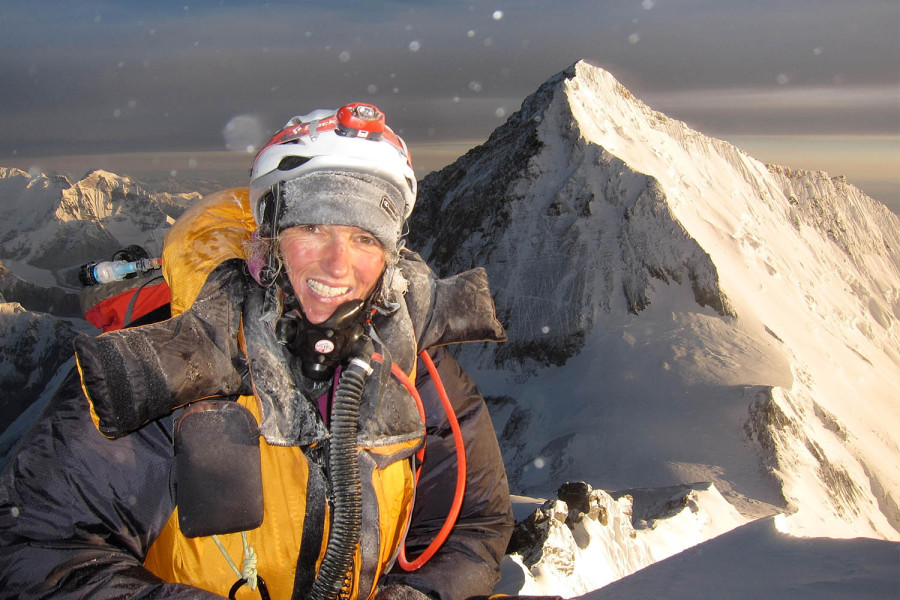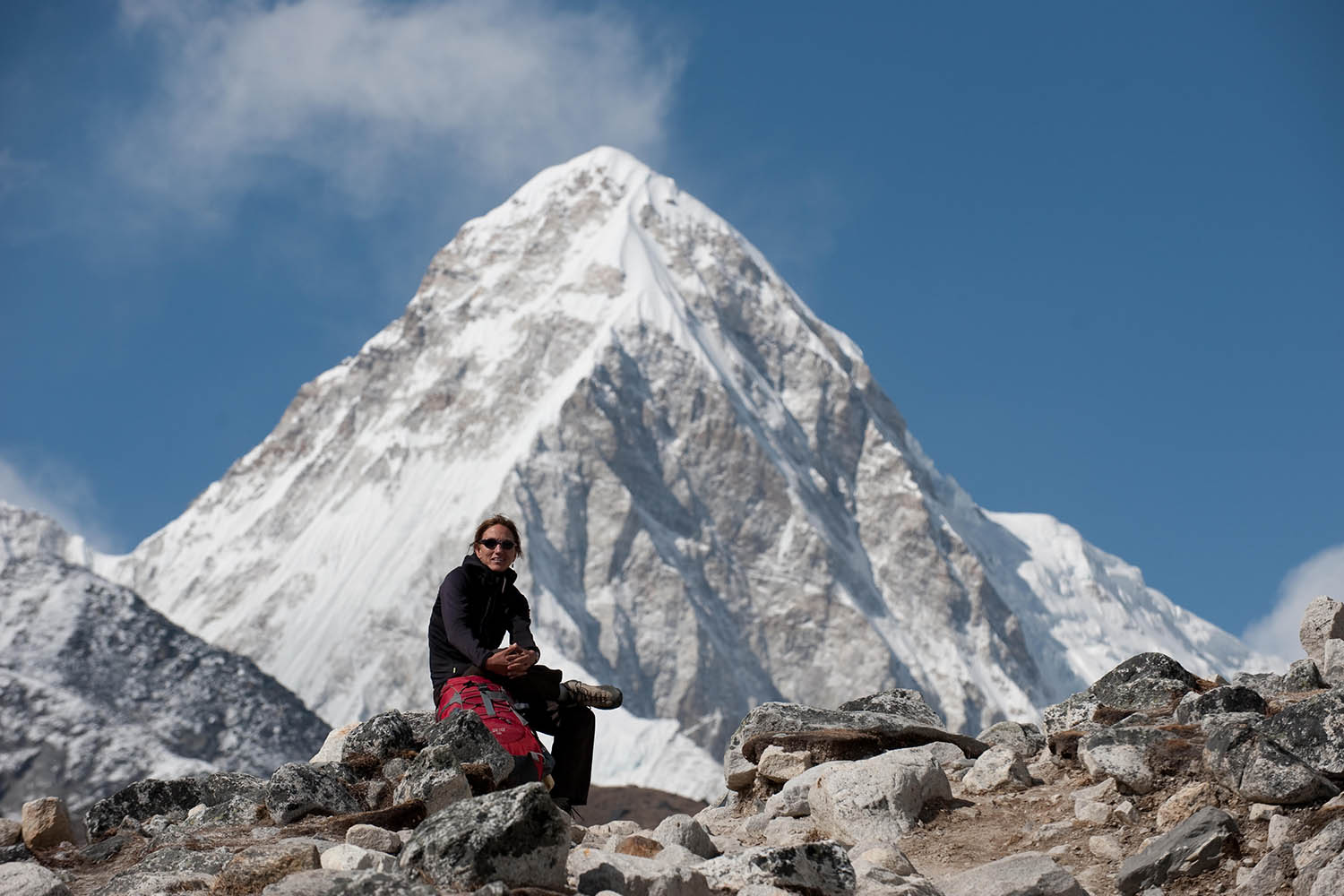Culture & Lifestyle
The mountain chronicler
Once averse to the mountains, Billi Bierling now dedicates her life to recording Nepal’s climbing history. Through the Himalayan Database, she captures the evolving face of mountaineering.
Xenia Klaus
Billi Bierling was not a sporty child, even though her father was a runner. “Once, my dad offered me money to jog around a lake close to our house—an 8-kilometer run. I told him he was crazy. I would never do this.” Nor did Bierling like to hike the mountains surrounding the family's home in the German town of Garmisch-Partenkirchen. “I considered them a nuisance as they were limiting my horizon.” In the end, a British man and an American woman brought a change in her heart. They set her on the path to be the face and soul of the Himalayan Database, which has recorded all important ascents in the Nepal Himalayas since 1963.
After secondary school, “I was a horrible student, a hopeless case they called me,” she says. She then decided she would not settle down and find a proper job. Instead, she set out to work as a nanny in the US for a year and then, after still not feeling any inclination to stay in the calm Garmisch-Partenkirchen area—she moved to Great Britain. There, she fell in love with a local. Like many Brits, this one felt the urge to climb far-away mountains, and he dragged the by-then 24-year-old Bierling along on a trip to Nepal. That was in 1998. They set out to summit Parchamo and Mera Peak. “We were out there for two months. I discovered that I loved the expedition life.”
Upon their return to Kathmandu, Bierling and her boyfriend were interviewed by the American archivist Miss Elizabeth Hawley. In the 1960s, she founded the Himalaya database, keeping track of all expeditions to Nepal's highest mountains and interviewing all mountaineers. Bierling left Kathmandu without knowing that this interview would change the course of her biography.
Do it yourself
After breaking up with the British mountaineer, Bierling met a Swiss mountain guide with whom she continued climbing mountains. “At one point, I wondered whether I climbed these mountains because of my passion or my partners. The answer came during a difficult time for me. I had fractured my hip while running,” she recalls. Bierling lived in the then Swiss capital, Berne, and the Alps seemed extremely close on clear days. “On such a clear day, I was hobbling across a bridge, and my sight fell on some of the most famous Swiss mountains. I could almost physically feel their draw. From then on, I knew: I wanted to go to the mountains. For myself and not for anybody else,” she says.
Six years after that first trip to Nepal, the British and the Swiss were no longer Bierlings’s boyfriends, but one companion stayed: her restlessness. She reminisced on her time in Nepal and sought an excuse to return. When trying to come up with a reason to return, she remembered the interview she had given to Elizabeth Hawley. She wrote the old lady a letter asking if she needed help with the database work. Why not, was the reply.
Ever since Bierling has spent about half her time in Nepal and half in other places. She always arrives just in time for the expedition seasons. Hawley retired from her work on the database in 2016, aged 94 and passed away two years later. After her retirement, Bierling took over completely. “Though we are working in a team,” she says. Bierling says a permanent move to Nepal was never in question. For one, she is too inclined to see other parts of the world. For the other, she is very close with her now 91-year-old mom. She takes a quick break in the interview to exchange voice messages and inquire about the English class her mother is taking.

Who’s the first?
In the past 20 years, Bierling has been keeping track of expeditions in Nepal. “When I started, the Westerners dominated the expedition industry. After 2010, we saw a rapid shift. Today, Nepali climbers dominate. Which is, of course, only right as we are in Nepal,” she explains. Something which would have been unfathomable in the times of Elizabeth Hawley, “She came from an old, colonial world. In her archives, a Sherpa was never an expedition leader.”
Also, the work on the database itself has changed dramatically, “When I started, the expeditions were few; it was possible to interview all of them.” Bierling would call up the big trekking agencies and ask them for a list of the expeditions they were running. Then, they called up the hotels where they were accommodated in Kathmandu. Though this was somewhat repetitive then, it has become impossible, “Today, so many people come to climb Nepal’s mountains, and it’s impossible to interview them all. However, the Ministry of Tourism is helpful and kindly shares their expedition data with us,” she says. If climbers explore a new route or attempt unclimbed peaks, Bierling and the Himalayan Database team will still hunt the people down and interview them. “But the significance of the database is not the same as it used to be. Most people who climb these mountains have their own social media pages or blogs where they describe their climbs in detail. Nevertheless, I still think it has a strong historical value and deserves to be continued for another while,” she explains.
Due to the extensive data collected by the database, Bierling receives numerous inquiries. For instance, she can explain how many teachers in their 50s have climbed Annapurna. Many people are eager to determine if they are the ‘first’ in something. This doesn’t necessarily refer to first ascents but could be something like ‘the first school teacher in their 50s to climb Annapurna’. However, Bierling clarifies that these are not official records but mere coincidences. She adds that many people feel disappointed if they don’t hold some kind of “first.” "I feel bad for them," Bierling says, "They've accomplished something incredible, like summiting an 8000er, and probably had an amazing experience, yet they feel let down because they weren’t the first in any specific way." The strangest query she received was from a woman asking if she was the first woman on Everest with the longest hair. Even the Himalayan Database couldn’t provide an answer for that.
Still not a hiker
The database is worked on voluntarily. But if the records don’t matter, why even keep track? “Well, what I have experienced and learnt through the Himalayan Database is worth much more than any money in the world. I have met wonderful people; I had the chance to spend much time in Nepal,” says Bierling.
Eleven years after setting foot on Nepali soil and after five years of hearing the accounts of countless expedition team members, Bierling decided it was time to see for herself what the world looked like on its very top, and she tagged along on an Everest Expedition. “I joined a commercial expedition with fixed ropes, high altitude guides and bottled oxygen. I am not a good enough mountaineer to be able to climb these big peaks without such essential support. I would not have climbed any of my six 8,000m peaks without the amazing help of the Sherpas.”
However, one thing has stayed the same since Bierling was a child, “Up to this day, I do not like hiking. If somebody invites me to come on a day trip walking up some mountain in Germany or Switzerland, I usually decline.” But a long trek where you spend two or three weeks on the trails or a high-altitude climb is something else to her, “The quest becomes your life, and while the quest is very hard, life becomes very simple. That I love dearly.”




 15.12°C Kathmandu
15.12°C Kathmandu















